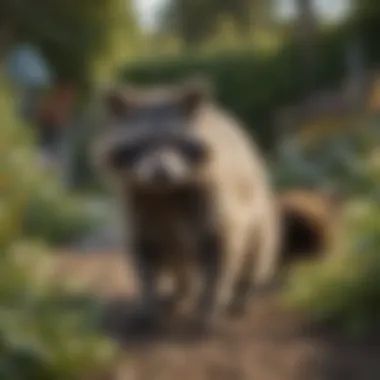Strategies for Urban Raccoon Population Management


Intro
Raccoons have become a prominent issue in both urban and suburban areas. Their adaptability and problem-solving skills allow them to thrive in environments altered by humans. As homeowners and residents encounter more frequent interactions with these creatures, it is vital to understand effective strategies to manage raccoon populations while maintaining ecological balance. This article aims to provide valuable insights and practical approaches to equip readers with the knowledge needed for successful raccoon management.
Understanding the Pest
Identification
Raccoons, scientifically known as Procyon lotor, are medium-sized mammals easily characterized by their distinct appearance. They have a bushy tail, a masked face with dark fur around the eyes, and an often grayish-brown coat. Recognizing these features can aid homeowners in identifying potential raccoon activity in their vicinity. Typically, these animals are active at night, displaying a unique level of curiosity and intelligence. Homeowners may notice signs of raccoon presence through overturned trash cans, nests in attics, or distinctive tracks leading to areas where food is accessible.
Life Cycle
Understanding the raccoon life cycle is crucial for effective management. Raccoons typically mate in winter, with a gestation period lasting about 63 days. Female raccoons give birth to litters averaging three to seven kits in late spring. The kits remain dependent on their mother for approximately six months, during which they learn essential survival skills. Awareness of this life cycle enables homeowners to time their management efforts effectively, particularly during the spring and summer months when raccoon activity peaks.
Pest Prevention Strategies
Environment Modification
Preventing raccoons from invading a property starts with modifying the environment. Here are several methods:
- Secure Garbage: Use raccoon-proof containers or enclosures for trash.
- Remove Food Sources: Clean pet food dishes and remove bird feeders during raccoon activity hours.
- Landscape Modification: Trim trees and shrubs that provide shelter or food for raccoons.
Physical Barriers
In addition to environmental modification, physical barriers can deter raccoons from entering properties. Fencing plays a critical role in keeping these animals at bay. A fence should be at least four feet high and buried a foot underground to prevent digging.
Control Methods
Chemical Control
Chemical control methods should be seen as a last resort, as these can impact surrounding wildlife and ecosystems. Aversion products, such as taste aversion or scent repellents, are alternatives to more aggressive tactics. Homeowners should always consider the potential consequences of chemical use before employing this method.
Biological Control
Biological control involves leveraging natural predators or competitors to manage raccoon populations. However, this method is not commonly used for raccoons due to their adaptability and resilience. It is essential to work within legal boundaries and ensure that any biological methods are sustainable and do not disrupt local ecosystems.
Through this comprehensive understanding and outline of raccoon management strategies, homeowners can better address the challenges posed by these intelligent mammals, achieving a balance between human needs and ecological considerations.
Understanding Raccoons
Understanding raccoons is central to effectively managing their populations in urban and suburban areas. These creatures are highly adaptable and intelligent, which can complicate human interactions with them. By learning their biological and behavioral characteristics, homeowners can develop strategies that minimize conflicts while considering the needs of both humans and raccoons. Understanding these aspects gives the necessary foundation for other management strategies thus leading to effective control methods with less reliance on harmful tactics.
Biological Characteristics
Physical appearance
Raccoons are easily recognized due to their distinct physical traits. They typically have a stocky body, grayish fur, and a unique black mask pattern around their eyes. Their dexterous front paws enable them to manipulate objects and open containers, which poses challenges for urban living. This characteristic allows them to access human food sources, contributing to their adaptability.
In the context of managing raccoon populations, recognizing their physical traits is crucial. It helps inform residents of the measures they should implement to secure their properties.
Adaptations for urban living
Raccoons have several adaptations that allow them to thrive in urban environments. Their omnivorous diet enables them to exploit a variety of food sources, such as garbage, pet food, and garden produce. Additionally, they are known for their nocturnal behaviors, which reduce direct encounters with humans and increase their foraging success.
This adaptability is a double-edged sword. While it allows raccoons to survive in urban settings, it also leads to increased conflicts with humans, making understanding these adaptations vital in designing effective management strategies.
Life cycle and reproduction
Raccoons typically breed once a year, with a gestation period of about 63 days. A female usually gives birth to two to five kits, who stay with their mother for about a year. This reproductive pattern contributes to the rapid increase in raccoon populations if management measures are not in place.
Understanding the life cycle is essential for anticipating population booms and implementing preventive strategies. Without awareness of these reproductive patterns, residents may find themselves facing an overwhelming number of raccoons.
Behavioral Patterns
Feeding habits
Raccoons are opportunistic feeders. They will consume whatever food is available, including human leftovers and pet food. This behavior is critical to understand as it influences how raccoons interact with human habitats. When neighborhoods do not take measures to secure waste and food sources, raccoons are more likely to venture into these areas.


Changing feeding habits through community awareness can lead to a significant reduction in raccoon populations.
Social behavior
Raccoons display a range of social behaviors. They can be solitary, but they often form small groups, especially when foraging. Understanding these social mechanisms can inform community strategies, emphasizing the importance of collaboration in reducing raccoon populations.
Being aware of raccoon social behavior can help in developing successful deterrent strategies that consider their group dynamics.
Territoriality
Raccoons are territorial animals. Males often maintain a territory where they can access food and mates. This territoriality can lead to conflicts, particularly when territories overlap in urban settings. By observing and understanding these territorial behaviors, homeowners can avoid attracting these animals into their space when managing raccoon populations.
Recognizing the territoriality of raccoons aids in crafting measures that minimize encounters and reduce the potential for conflict in suburban areas.
Legal Considerations
Understanding legal frameworks surrounding raccoon management is essential for effective population control. Laws not only influence how homeowners approach raccoon presence but also shape community expectations and responsibilities. Adhering to regulations prevents potential conflicts with wildlife and promotes a more balanced coexistence.
Local Regulations
Wildlife protection laws
Wildlife protection laws are fundamental regulations that exist to protect various species, including raccoons. These laws aim at conserving wildlife populations and ensuring their survival in natural habitats. They often restrict how individuals can interact with these animals, which can influence urban settings where human-wildlife conflicts frequently arise. A key characteristic of wildlife protection laws is that they necessitate humane treatment of animals. This approach fosters a society that respects and values the integrity of local ecosystems.
The unique feature of these laws is their capacity to promote sustainable interaction with wildlife. They often require educational outreach, encouraging communities to learn about local fauna and their ecological roles. While such regulations can hinder immediate removal efforts for raccoons, they ultimately contribute to developing long-term, sustainable strategies for managing wildlife within urban settings.
Permits for relocation
Permits for relocation are another significant aspect of managing raccoon populations. These permits ensure that any relocation efforts are carried out legally and responsibly, minimizing stress for the animals involved. The key characteristic of requiring permits is that it regulates where and how raccoons can be relocated. This regulatory mechanism helps to ensure the animals are moved to suitable habitats where they can thrive without causing issues for other communities.
The unique aspect of this permit requirement is it encourages community members to engage with local wildlife agencies, creating a collaborative approach to wildlife management. While obtaining permits can be seen as a hurdle by some, it enhances accountability and elevates the standards of treatment for displaced raccoons.
Fines for illegal traps
Fines for illegal traps are critical in maintaining the integrity of raccoon management practices. Such penalties discourage individuals from using inhumane trapping methods which can inflict unnecessary suffering on these animals. This regulation serves as a deterrent to illegal hunting and trapping, reinforcing the importance of humane wildlife control methods.
The key characteristic of fines is that they ensure individuals adhere to established laws. They support ethical conduct in wildlife management and foster a respectful relationship between humans and raccoons. The disadvantage, however, might be that these fines do not always prevent illegal activities, but with ongoing community education, the benefits of compliance become more apparent to residents.
Ethical Considerations
The ethical treatment of raccoons reflects society's collective values concerning wildlife conservation. This layer of consideration emphasizes the duty of individuals and communities to manage raccoon populations ethically, promoting awareness and responsibility towards these animals in urban environments.
Humane treatment
Humane treatment protocols outline the best practices for how raccoons should be approached during capture and relocation. Such guidelines ensure that methods used do not cause undue harm or suffering. The key rationale behind humane treatment practices is rooted in compassion and respect for wildlife.
The standout feature of humane treatment is that it strengthens community commitment to ethical wildlife management. By prioritizing humane methods, communities can work to minimize conflicts while fostering a more sustainable environment. However, some critics argue that humane treatment can be time-consuming, which might delay necessary action in immediate conflict situations.
Conservation perspectives
Conservation perspectives highlight the need for preserving raccoon populations as a vital part of the ecosystem. Recognizing the ecological role of raccoons informs management strategies by promoting biodiversity and ecological balance. A strong characteristic of conservation perspectives is their emphasis on long-term benefits over short-term fixes.
This perspective promotes a community culture focused on ecological integrity. Conservation encourages collaborative efforts between residents and local agencies to develop solutions. Yet, this approach may meet resistance from those prioritizing immediate human concerns over ecological considerations.
Community responsibility
Community responsibility refers to the obligation of local residents to engage in ethical practices regarding wildlife management. This concept underscores mutual accountability among community members in ensuring raccoons are treated fairly. The key characteristic of community responsibility is that it shifts the narrative from individual to collective action.
This engagement encourages community initiatives to create better living conditions for both raccoons and humans. By emphasizing education and participation, community responsibility builds awareness and cooperation. However, ensuring widespread participation can be challenging, as not every resident may feel inclined to engage in wildlife issues.
Preventive Measures
Preventive measures play a crucial role in managing raccoon populations, particularly in urban areas where human-wildlife interactions are frequent. By implementing these strategies, residents can not only protect their properties but also minimize potential conflicts with these animals. Preventive actions reduce attractants and make environments less hospitable for raccoons. Moreover, fostering a community approach to these measures can enhance their effectiveness and ensure long-term success.
Environmental Modifications
Secure trash containers


One of the key aspects of managing raccoons is securing trash containers. Raccoons are opportunistic feeders and are often drawn to easily accessible food sources. By using secure, raccoon-proof trash cans, homeowners can significantly decrease the likelihood of attracting raccoons to their properties.
These containers are designed with locking mechanisms that prevent raccoons from opening them. This characteristic makes them an ideal choice for those wanting to keep raccoons at bay. The unique feature of these containers is their ability to withstand tampering, making it hard for animals to get to waste. An advantage is that they can often be easily sourced at home improvement stores. However, they can come at a higher cost compared to regular bins.
Seal entry points
Another important preventive measure is sealing entry points around homes. Many homeowners may not realize how easily raccoons can access attics, basements, or even garages. Sealing gaps and openings is essential in deterring raccoons from entering structures.
Key characteristics include the use of durable materials for sealing, such as metal mesh or caulk. This method is broadly effective as it minimizes potential entryways. One unique feature is that it can often be performed as a DIY project, reducing the need for professional help. The disadvantage, however, lies in the thoroughness required—if even small gaps are left unsealed, raccoons may still gain access.
Remove attractants
Finally, removing attractants is critical in preventive measures. This involves eliminating sources of food and shelter that raccoons might find appealing. Homeowners should ensure that pet food is not left outside and bird feeders are not readily accessible.
This strategy is significant as it directly tackles one of the root causes of human-raccoon interactions. The key characteristic of this method is its simplicity and low cost; many solutions simply require behavior changes. Additionally, establishing a clean environment can deter not only raccoons but other wildlife as well. The downside is it requires commitment from residents to maintain these practices, which can sometimes be overlooked during busy periods.
Community Initiatives
Community initiatives play a valuable role in raccoon management. A collective effort allows for the implementation of broader strategies that can lead to greater success in mitigating raccoon populations. Such initiatives promote sustainability and awareness among residents, which is vital for long-term coexistence with local wildlife.
Public awareness campaigns
Public awareness campaigns are essential for educating the community about the impacts of raccoon populations. These campaigns inform residents about safe waste management practices and the importance of not feeding wildlife.
A key characteristic is their ability to engage a wide audience through various channels, including social media and local outreach efforts. By bringing attention to the risks associated with attracting raccoons, communities can work towards reducing common attractants. One unique feature of these campaigns is their adaptability; they can be tailored to fit specific community needs and contexts. However, the challenge remains in sustaining community interest over time and ensuring participation.
Neighborhood watch programs
Neighborhood watch programs can also be an effective tool for managing raccoon populations. These programs encourage residents to monitor their neighborhoods for signs of raccoon activity.
A key characteristic of neighborhood watches is the emphasis on community collaboration. This collective vigilance fosters a sense of responsibility towards wildlife management. Moreover, they can facilitate information sharing among neighbors about successful raccoon management strategies. The unique feature here is the empowerment of residents to take action and report issues. On the contrary, a disadvantage is that there may be varying levels of commitment among community members, leading to inconsistent efforts.
Collaboration with local wildlife agencies
Collaboration with local wildlife agencies can enhance the effectiveness of raccoon management strategies. Wildlife agencies offer expertise and resources that can aid in the implementation of humane control methods.
The key characteristic of this collaboration is access to professional advice and potential intervention strategies that are compliant with local laws. Such partnerships often focus on educating the public about raccoon behavior and ecology, which is beneficial for community knowledge. Unique features include workshops and information sessions that make expert knowledge accessible. Nevertheless, the challenge lies in ensuring that residents take advantage of these resources—there may be gaps in communication or awareness.
Humane Control Methods
Managing raccoon populations humanely is crucial for maintaining ecological balance and ensuring the safety of both humans and wildlife. By emphasizing humane control methods, urban and suburban areas can foster coexistence rather than conflict. Humane approaches not only reduce stress on raccoon populations but also minimize the risk of injury or harm to humans. This section discusses various techniques that respect raccoons' natural behaviors while addressing human concerns.
Relocation Techniques
Relocation is considered a common humane method for managing raccoon populations. This process involves capturing raccoons and moving them to a safer environment. There are several important aspects that should be considered during this technique.
Trap and transport guidelines
The guidelines for trapping and transporting raccoons are essential to ensuring their safety and well-being. Utilizing appropriate traps is vital, as it allows for the humane capture of the animal without causing injury. A key characteristic of these guidelines is the emphasis on using live traps, which do not harm the animal. This method stands out as a popular choice in humane control because it aligns with ethical considerations
Key features include:
- Type of traps - Live traps should have proper ventilation and space for the animal's comfort.
- Distance to transportation - Transporting the raccoon should be for a reasonable distance to avoid stress factors, as excessive travel can be harmful to the animal.
Advantages of these guidelines lie in their humane approach which prevents unnecessary suffering. However, disadvantages might include potential legal restrictions on transport locations, making it important to consult local laws before proceeding.
Choosing relocation sites
The selection of relocation sites plays a pivotal role in the success of raccoon relocation efforts. An ideal site should provide natural shelter and food sources, ensuring the raccoons can thrive away from urban centers. This method is essential in reducing the chances of the raccoons returning to their original habitat.
Key characteristics include:
- Natural habitat - Relocation sites should mimic the raccoon's natural environment.
- Distance from urban areas - A sufficient distance from urban centers is needed to ensure the raccoons do not return.
Unique features of choosing suitable relocation sites involve understanding raccoon behavior and habitats. This technique greatly improves the odds of successful adaptation in their new environment. However, misjudgment in choosing these locations can result in further issues, including human-wildlife conflicts in new areas involving higher populations.
Post-relocation monitoring


Post-relocation monitoring is crucial to assess the effectiveness of the relocation process. By tracking how raccoons adapt to their new surroundings, it offers insights into the success of the humane control method. Essentially, it contributes to the overall goal of ensuring that both the raccoons' needs and community safety are considered.
A key characteristic of this monitoring involves:
- Documentation of behaviors - Observing the raccoons’ responses helps understand their adjustment period and survival rate.
- Continued management - Active involvement in monitoring can lead to better management practices in the future.
By monitoring post-relocation, communities can adjust future strategies based on observed behaviors. The unique feature of this technique is it allows for adaptive management practices for raccoon populations. On the downside, post-relocation monitoring requires resources and coordination, which might be challenging for individuals.
Non-lethal Deterrents
Non-lethal deterrents provide a method to manage raccoon populations while maintaining their welfare. These techniques help in minimizing conflicts by repelling raccoons instead of causing harm.
Ultrasonic repellents
Ultrasonic repellents emit high-frequency sounds that are unpleasant to raccoons but imperceptible to humans. These devices are considered a humane option as they do not cause any physical harm to the animals. The most significant aspect is their ease of use.
Key characteristics include:
- Sound frequency - Designed to trigger discomfort without direct interaction.
- Ease of installation - Can be easily set up in areas prone to raccoon visits.
The advantages of ultrasonic repellents are their harmless nature and minimal maintenance. However, disadvantages include the possibility of diminishing effectiveness over time as raccoons may become accustomed to the sound.
Chemical repellents
Chemical repellents deter raccoons through smell. These substances produce scents that raccoons find intolerable. Utilizing these repellents aligns with humane practices as they do not inflict pain.
Key characteristics include:
- Types of scents - Common ones include citrus or predator scents, which can effectively dissuade them from entering certain areas.
- Application methods - Can be applied in gardens or garbage areas to keep raccoons at bay.
Chemical repellents can be an effective strategy to create barriers between raccoons and human spaces. However, the disadvantages pertain to potential environmental impacts and the need for reapplication to maintain effectiveness.
Visual deterrents
Visual deterrents rely on sight to discourage raccoons from entering specific areas. Reflective surfaces and various bright objects are commonly used techniques. These methods can be simple yet effective in deterring raccoons without causing them harm.
Key characteristics include:
- Types of objects - Items like aluminum foil, reflective tape, or fake predators can frighten raccoons.
- Strategic placement - Positioning these objects strategically can enhance their deterrent effects.
The advantages involve low costs and easy implementation, making them very accessible for homeowners. Nevertheless, visual deterrents may lose effectiveness outside of the immediate area, necessitating occasional repositioning or replacement.
Long-Term Solutions
Long-term solutions are crucial for managing raccoon populations effectively. These strategies go beyond immediate reactions to raccoon encounters and focus on sustainable management practices. Implementing long-term solutions provides benefits such as reducing the need for repeated interventions, fostering harmony between raccoons and humans, and promoting a healthier ecosystem. Strong habitat management and continuous education efforts play key roles in achieving these objectives.
Habitat Management
Landscaping choices
Landscaping choices are significant in shaping the environment around homes. Selecting native plants instead of exotic species can discourage raccoons. Native plants often require less maintenance and support local wildlife, which can balance the ecosystem. When homeowners avoid open, fruit-bearing trees near their houses, it makes the area less attractive to raccoons. An advantage of landscaping carefully is that it improves the aesthetic appeal of neighborhoods while reducing potential raccoon sightings. However, caution should be exercised since poorly chosen plants can attract pests instead.
Natural barriers
Natural barriers, like dense shrubs or thorny bushes, act as a deterrent for raccoons. These physical obstructions prevent easy access to residential areas. The key characteristic of natural barriers is that they are environmentally friendly and require minimal upkeep. They contribute positively by maintaining the ecosystem balance. An important aspect of this solution is that they can also provide habitats for beneficial wildlife. A possible disadvantage is that if not properly maintained, these areas could become overgrown, potentially creating hiding places for raccoons.
Community green spaces
Community green spaces serve as important buffers between human residences and raccoon habitats. They allow for natural wildlife movement and help retain the local fauna. Green spaces encourage biodiversity, as they often include a variety of plant species. This can also provide educational opportunities for local communities about native flora and fauna. An advantage of developing such spaces is the promotion of ecological awareness in neighborhoods. However, poorly designed areas could become gathering spots for raccoons if not managed properly.
Ongoing Education
Workshops and training
Workshops and training sessions are essential for disseminating knowledge on raccoon management. These events can bring together homeowners, local wildlife agencies, and pest control professionals. The primary characteristic of these workshops is their interactive nature, allowing attendees to ask questions and share experiences. A significant benefit of these initiatives is the shared community understanding of best practices in raccoon management. On the downside, organizing these may require funding and resources that not all communities readily have.
Informative resources
Informative resources help to bridge the knowledge gap concerning raccoon behavior and management techniques. These could include pamphlets, online guides, or dedicated sections in community newsletters. The key component of informative resources is their accessibility to the general public, increasing awareness about humane management methods. Having these resources readily available improves the likelihood that residents will take proactive measures. However, without promotion, these resources may go unnoticed.
Engagement with local schools
Engagement with local schools transforms younger generations into informed citizens regarding wildlife. Programs that introduce raccoon behavior and management tactics can nurture a sense of responsibility in youth. A key characteristic of such initiatives is that they embed ecological considerations within the local culture. This outreach can lead to long-term advocacy for wildlife management in future adults. Nonetheless, educational programs must be regularly updated to stay relevant and may face challenges in securing curriculum time.







